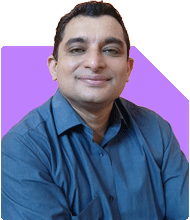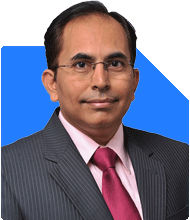Ramalingam Kalirajan |10902 Answers |Ask -Follow
Mutual Funds, Financial Planning Expert - Answered on May 27, 2024
He has an MBA in finance from the University of Madras and is a certified financial planner.
He is the director and chief financial planner at Holistic Investment, a Chennai-based firm that offers financial planning and wealth management advice.... more

Hi Sir , I have deposited 20 lakhs in Fixed deposit. How can i invest in mutual fund lumpsum amount for better returns?
Investing a lump sum like Rs. 20 lakhs into mutual funds can provide better returns compared to fixed deposits. However, managing risk and ensuring steady growth requires a strategic approach. One effective method is using a Systematic Transfer Plan (STP).
Understanding Systematic Transfer Plan (STP)
What is an STP?
Gradual Investment
An STP allows you to transfer a fixed amount from a debt fund to an equity fund periodically. This method reduces market timing risks and averages out the cost of investment.
Benefits of STP
Risk Management
STPs help manage market volatility by spreading investments over time, reducing the impact of market fluctuations.
Regular Investments
They ensure disciplined investing, taking advantage of market corrections and benefiting from rupee cost averaging.
Step-by-Step Guide to Using STP
Step 1: Choose a Debt Fund
Safe Parking
Start by investing your lump sum in a debt fund. Debt funds are less volatile and provide regular income, making them a safe place to park your money initially.
Step 2: Select an Equity Fund
Growth Potential
Choose an equity fund based on your risk tolerance and financial goals. Equity funds offer higher returns over the long term but come with higher risk.
Step 3: Determine the Transfer Amount
Consistency
Decide the amount to transfer from the debt fund to the equity fund periodically. Common intervals are monthly or quarterly, depending on your preference.
Step 4: Set Up the STP
Automated Transfers
Set up the STP with your mutual fund provider. Specify the transfer amount and interval, ensuring the process is automated and hassle-free.
Benefits of Using Debt Funds Initially
Capital Preservation
Minimize Risk
Starting with a debt fund helps preserve your capital while earning a steady return. It provides a cushion against market volatility during the initial phase of your investment.
Regular Income
Steady Returns
Debt funds offer regular income through interest payments, which can be reinvested or used for other financial needs.
Choosing the Right Equity Funds
Diversification
Spread Risk
Select equity funds that offer diversification across sectors and market capitalizations. This strategy spreads risk and enhances growth potential.
Fund Performance
Track Record
Evaluate the historical performance of the equity funds. Consistent returns over different market cycles indicate reliable funds.
Fund Manager Expertise
Professional Management
Consider funds managed by experienced professionals. Their expertise can significantly impact the fund's performance and your investment returns.
Advantages of Actively Managed Funds
Professional Management
Expert Decisions
Actively managed funds benefit from professional fund managers who make informed decisions based on market research and conditions.
Potential for Higher Returns
Market Opportunities
Fund managers aim to outperform benchmarks, providing higher returns than passively managed funds like index funds.
Disadvantages of Index Funds
Limited Growth
Market Replication
Index funds replicate market indices, limiting growth potential compared to actively managed funds, which can capitalize on market opportunities.
Lack of Flexibility
Fixed Portfolio
Index funds have a fixed portfolio and cannot adapt to changing market conditions, unlike actively managed funds.
Disadvantages of Direct Funds
Lack of Guidance
Navigating Complexity
Direct funds do not offer the expertise of a certified financial planner, making it challenging for less experienced investors to manage their investments effectively.
Time and Effort
Active Management Required
Direct funds require significant time and effort to manage, unlike regular funds managed by professionals.
Benefits of Regular Funds via MFD with CFP Credential
Expert Advice
Personalized Guidance
Investing through a CFP ensures personalized advice tailored to your financial goals, risk profile, and investment horizon.
Better Performance
Professional Oversight
Professionally managed regular funds often perform better due to the expertise of fund managers, providing higher returns and better risk management.
Holistic Planning
Comprehensive Approach
A CFP considers all aspects of your financial situation, helping you achieve your goals efficiently and effectively.
Building a Diversified Portfolio
Mix of Funds
Balance and Growth
A balanced portfolio includes a mix of equity, debt, and hybrid funds. This approach manages risk while optimizing returns.
Regular Review
Performance Monitoring
Regularly review your portfolio to ensure it aligns with your goals. Make necessary adjustments based on performance and changing market conditions.
Systematic Investment Plan (SIP)
Disciplined Investing
Consistency
SIPs promote disciplined investing by allowing you to invest a fixed amount regularly, leveraging the power of compounding over time.
Flexibility
Adjustable Investments
SIPs are flexible, enabling you to increase or decrease your investment amounts based on your financial situation and goals.
Suggested Mutual Funds for Diversified Investment
Here are some categories of mutual funds to consider for a diversified investment portfolio:
Large-Cap Fund: Stability and steady growth from well-established companies.
Mid-Cap Fund: Potential for higher returns with moderate risk.
Small-Cap Fund: High growth potential with higher risk.
Aggressive Hybrid Fund: Balanced growth with a focus on equities.
Conservative Hybrid Fund: Stability with a focus on debt instruments.
Short-Term Debt Fund: Lower risk for short-term investments.
Long-Term Debt Fund: Better returns for long-term investments.
Multi-Cap Fund: Diversified across large, mid, and small-cap stocks.
Sectoral/Thematic Fund: Focus on specific sectors for higher returns.
International Fund: Exposure to global markets for additional diversification.
Conclusion
Investing Rs. 20 lakhs in mutual funds through an STP can provide better returns while managing risk. Start by parking your funds in a debt fund and gradually transferring to equity funds. This approach ensures disciplined investing and takes advantage of market opportunities.
Consult with a certified financial planner to receive personalized advice and build a diversified portfolio tailored to your financial goals. Regularly review your investments to stay on track and achieve optimal returns.
Best Regards,
K. Ramalingam, MBA, CFP,
Chief Financial Planner,
www.holisticinvestment.in
You may like to see similar questions and answers below
Ramalingam Kalirajan |10902 Answers |Ask -Follow
Mutual Funds, Financial Planning Expert - Answered on Apr 09, 2024
Ramalingam Kalirajan |10902 Answers |Ask -Follow
Mutual Funds, Financial Planning Expert - Answered on May 06, 2024
Ramalingam Kalirajan |10902 Answers |Ask -Follow
Mutual Funds, Financial Planning Expert - Answered on May 15, 2024
Ramalingam Kalirajan |10902 Answers |Ask -Follow
Mutual Funds, Financial Planning Expert - Answered on Aug 13, 2024
Ramalingam Kalirajan |10902 Answers |Ask -Follow
Mutual Funds, Financial Planning Expert - Answered on Dec 02, 2024
Anu Krishna |1749 Answers |Ask -Follow
Relationships Expert, Mind Coach - Answered on Dec 17, 2025
Anu Krishna |1749 Answers |Ask -Follow
Relationships Expert, Mind Coach - Answered on Dec 17, 2025
Radheshyam Zanwar |6748 Answers |Ask -Follow
MHT-CET, IIT-JEE, NEET-UG Expert - Answered on Dec 17, 2025
Anu Krishna |1749 Answers |Ask -Follow
Relationships Expert, Mind Coach - Answered on Dec 17, 2025
Dr Shakeeb Ahmed Khan |184 Answers |Ask -Follow
Physiotherapist - Answered on Dec 17, 2025
T S Khurana |538 Answers |Ask -Follow
Tax Expert - Answered on Dec 17, 2025
T S Khurana |538 Answers |Ask -Follow
Tax Expert - Answered on Dec 17, 2025
Janak Patel |72 Answers |Ask -Follow
MF, PF Expert - Answered on Dec 17, 2025
Ramalingam Kalirajan |10902 Answers |Ask -Follow
Mutual Funds, Financial Planning Expert - Answered on Dec 17, 2025
Samraat Jadhav |2511 Answers |Ask -Follow
Stock Market Expert - Answered on Dec 17, 2025


























